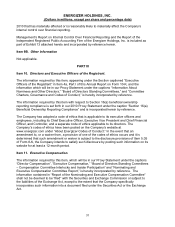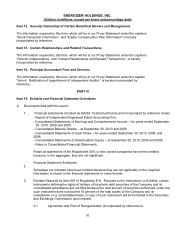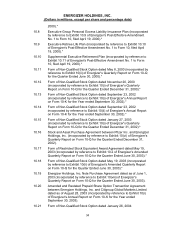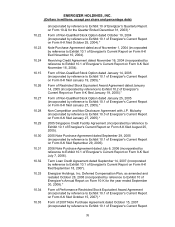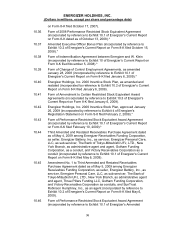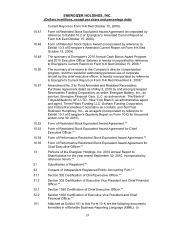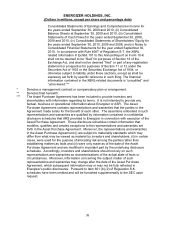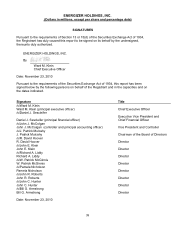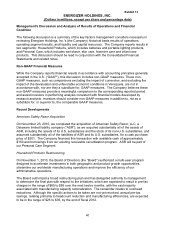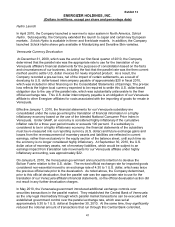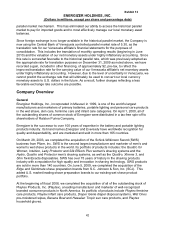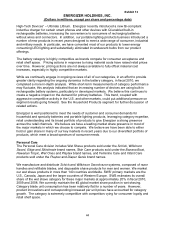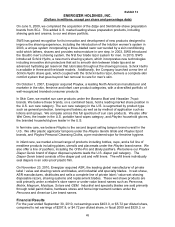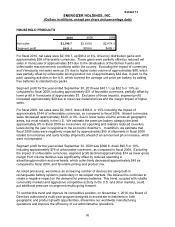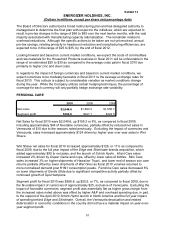Energizer 2010 Annual Report Download - page 51
Download and view the complete annual report
Please find page 51 of the 2010 Energizer annual report below. You can navigate through the pages in the report by either clicking on the pages listed below, or by using the keyword search tool below to find specific information within the annual report.
Exhibit 13
ENERGIZER HOLDINGS, INC.
(Dollars in millions, except per share and percentage data)
41
Hydro Launch
In April 2010, the Company launched a new men’s razor system in North America, Schick
Hydro. Subsequently, the Company extended the launch to Japan and certain key European
markets. Schick Hydro is available in three- and five-blade models. In addition, the Company
launched Schick Hydro shave gels available in Moisturizing and Sensitive Skin varieties.
Venezuela Currency Devaluation
At December 31, 2009, which was the end of our first fiscal quarter of 2010, the Company
determined that the parallel rate was the appropriate rate to use for the translation of our
Venezuela affiliate’s financial statements for the purposes of consolidation based on the facts
and circumstances of our business, including the fact that the parallel rate was the then current
method used to settle U.S. dollar invoices for newly imported product. As a result, the
Company recorded a pre-tax loss, net of the impact of certain settlements, as a result of
devaluing its U.S. dollar-based intercompany payable of approximately $20 in fiscal 2010,
which was included in other financing on the Consolidated Statements of Earnings. The pre-tax
loss reflects the higher local currency expected to be required to settle this U.S. dollar-based
obligation due to the use of the parallel rate, which was substantially unfavorable to the then
official exchange rate. This U.S. dollar intercompany payable is an obligation of our Venezuela
affiliate to other Energizer affiliates for costs associated with the importing of goods for resale in
Venezuela.
Effective January 1, 2010, the financial statements for our Venezuela subsidiary are
consolidated under the rules governing the translation of financial information in a highly
inflationary economy based on the use of the blended National Consumer Price Index in
Venezuela. Under GAAP, an economy is considered highly inflationary if the cumulative
inflation rate for a three year period meets or exceeds 100 percent. If a subsidiary is
considered to be in a highly inflationary economy, the financial statements of the subsidiary
must be re-measured into our reporting currency (U.S. dollar) and future exchange gains and
losses from the re-measurement of monetary assets and liabilities are reflected in current
earnings, rather than exclusively in the equity section of the balance sheet, until such time as
the economy is no longer considered highly inflationary. At September 30, 2010, the U.S.
dollar value of monetary assets, net of monetary liabilities, which would be subject to an
earnings impact from translation rate movements for our Venezuela affiliate under highly
inflationary accounting, was approximately $22.
On January 8, 2010, the Venezuelan government announced its intention to devalue the
Bolivar Fuerte relative to the U.S. dollar. The revised official exchange rate for imported goods
considered non-essential moved to an exchange rate of 4.30 to 1 U.S. dollar, which was twice
the previous official rate prior to the devaluation. As noted above, the Company determined,
prior to this official devaluation, that the parallel rate was the appropriate rate to use for the
translation of our Venezuela affiliate’s financial statements, so the official devaluation action did
not result in any further devaluation charges.
In May 2010, the Venezuela government introduced additional exchange controls over
securities transactions in the parallel market. They established the Central Bank of Venezuela
as the only legal intermediary through which parallel market transactions can be executed and
established government control over the parallel exchange rate, which was set at
approximately 5.30 to 1 U.S. dollar at September 30, 2010. At the same time, they significantly
reduced the notional amount of transactions that run through this Central Bank controlled,


